Kenneth L. Gentry Jr.'s Blog, page 43
September 21, 2021
LONG REIGN IN SHORT BOOK?
 PMW 2021-069 by Kenneth L. Gentry, Jr.
PMW 2021-069 by Kenneth L. Gentry, Jr.
Although the vast majority of Revelation focuses on events that will occur “soon” (Rev 1:1, 3), the Revelation 20 section on the thousand years begins, but is not completed, in the first century. It projects itself into the distant future, allowing a glimpse of the end result of the events beginning in the apostolic era.
In Rev 20:4 John focuses on the martyred saints, who participate in Christ’s heavenly rule (Rev 20:4): “the souls of those who had been beheaded for their witness and those who had not worshiped the beast.” Given John’s time-frame concern (cf. Rev 1:3, 9), his focus is on the martyrs of the first-century era (Rev 6:9–11; 7:9, 13–15; 11:7–12; 12:5; 13:7, 15; 14:13; 16:6; 17:6; 18:20, 24). In fact, 20:4 is the answer to the plea of the martyrs in Rev 6:9–11, as we can see from the strong parallels between the passages:
Rev 20:4
And I saw the souls of those who had been beheaded because of the testimony of Jesus and because of the word of God.
Rev 6:9
I saw underneath the altar the souls of those who had been slain because of the word of God, and because of the testimony which they had main-tained.
In Revelation 20:1–3 John explicates the first phase of Christ’s triumph over Satan: he is spiritually bound, being restricted from successfully accomplishing his evil design in history. In Revelation 20:7–10 we witness the second and concluding phase of Christ’s triumph: Satan is personally punished, being tormented in the eternal flames of the lake of fire. John employs this two-fold pattern of spiritual/physical realities followed by initial/conclusive realities in the resurrection reference in Revelation 20, as well.
Keys to the Book of Revelation
(DVDs by Ken Gentry)
Provides the necessary keys for opening Revelation to a deeper and clearer understanding.
See more study materials at: www.KennethGentry.com
The “first resurrection” secures the participation of the martyred saints in Christ’s rule (Rev 20:4–6). The context suggests that this resurrection may not be literal. After all, we see a chain binding Satan and a key locking the abyss. As in the case of the two-fold triumph over Satan, this is the initial, spiritual victory-resurrection. That is, it refers to the spiritual resurrection of the martyrs who are born again by God’s grace and enter heaven to new life. After all, elsewhere Scripture speaks of salvation as a spiritual resurrection: “We know that we have passed from death to life, because we love the brethren. He who does not love his brother abides in death” (1Jn 3:14; cp. See also: Ro 6:8–11; Eph 2:6; Col 2:13–14). For dramatic purposes John ties this resurrection to the martyr’s vindication in AD 70.
Elsewhere John, Revelation’s author, speaks of a non-literal resurrection that occurs at the moment of salvation, much like Rev 20 associates a non-literal resurrection with the martyrs’ vindication in AD 70. He presents this in such a way that it serves as an advance indication of the final eschatological resurrection:
“Most assuredly, I say to you, he who hears My word and believes in Him who sent Me has everlasting life, and shall not come into judgment, but has passed from death into life. Most assuredly, I say to you, the hour is coming, and now is, when the dead will hear the voice of the Son of God; and those who hear will live. For as the Father has life in Himself, so He has granted the Son to have life in Himself, and has given Him authority to execute judgment also, because He is the Son of Man. Do not marvel at this; for the hour is coming in which all who are in the graves will hear His voice and come forth; those who have done good, to the resurrection of life, and those who have done evil, to the resurrection of condemnation.” (Jn 5:24–29)
John presents the martyrs’ vindication metaphorically as their being resurrected to enthronement, which does not require a physical resurrection. This non-literal enthronement should not surprise us in that earlier he more broadly states that he “has made us kings and priests to His God and Father, to Him be glory and dominion forever and ever” (Rev 1:6). After all, Christians are “overcomers” (cf. 1Jn 2:13–14; 4:4; 5:4–5) and sit with Christ in heavenly rule: “To him who overcomes I will grant to sit with Me on My throne, as I also overcame and sat down with My Father on His throne” (Rev 3:21). As Paul puts it, Christ “raised us up together, and made us sit together in the heavenly places in Christ Jesus” (Eph 2:6).
Book of Revelation Made Easy
(by Ken Gentry)
Helpful introduction to Revelation presenting keys for interpreting. Also provides studies of basic issues in Revelation’s story-line.|
See more study materials at: www.KennethGentry.com
The “rest of the dead” do not participate in this first century, spiritual resurrection. In fact, they “do not live again until the thousand years” is finished (Rev 20:5). For John’s purposes, these dead probably refer to “the rest,” who were killed in Revelation 19:21 — the associates of the beast (Nero) who is slain in the context of AD 70. In the future they will be physically resurrected (implied) in order to experience “the second death” (eternal torment in both body and soul, Mt 10:28), which occurs on Judgment Day (Rev 20:11–15).
Click on the following images for more information on these studies:
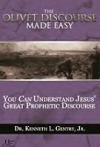

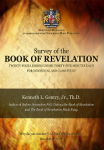
September 17, 2021
WHY STUDY ESCHATOLOGY
PMW 2021-068 by Kenneth L. Gentry, Jr.
 Doctrines revolving around the end of the world and the return of Christ are extremely popular today. And since his return is a foundational doctrine of the historic Christian faith, it well deserves our notice. Unfortunately though, the second advent is more deeply loved and firmly believed than biblically understood and accurately proclaimed. Evangelicals too often tend to have a “zeal without knowledge” when approaching this great biblical theme. This is especially tragic in that properly comprehending it is vitally important for framing in a Christian worldview. After all, it exalts the consummate glory of his redemptive victory, completes God’s sovereign plan for history, and balances a full-orbed theology of Scripture. In this regard I would note:
Doctrines revolving around the end of the world and the return of Christ are extremely popular today. And since his return is a foundational doctrine of the historic Christian faith, it well deserves our notice. Unfortunately though, the second advent is more deeply loved and firmly believed than biblically understood and accurately proclaimed. Evangelicals too often tend to have a “zeal without knowledge” when approaching this great biblical theme. This is especially tragic in that properly comprehending it is vitally important for framing in a Christian worldview. After all, it exalts the consummate glory of his redemptive victory, completes God’s sovereign plan for history, and balances a full-orbed theology of Scripture. In this regard I would note:
Christ’s victory
First, the second coming exalts the victory of Christ in redemption. When Christ comes in his first century incarnation, he comes in a state of humiliation. That is, he dwells among sinners in the dust of the earth, suffers rejection, abuse, and torment from them, then dies in agony on the cross, experiencing even rejection by God the Father (Mt 27:46//), and is buried in a tomb in the dust of the earth. As Paul expresses it: “being found in human form, he humbled himself by becoming obedient to the point of death, even death on a cross” (Php 2:8; cp. Mt 1:21; Lk 19:10). But Scripture does not leave him on the cross or in the tomb; it teaches his consequent glorification through four steps: resurrection, ascension, session, and, ultimately, return.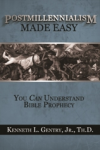
Postmillennialism Made Easy (by Ken Gentry)
Basic introduction to postmillennialism. Presents the essence of the postmillennial argument and answers the leading objections. And all in a succinct, introductory fashion.
See more study materials at: www.KennethGentry.com
Christ’s return in glory is necessary for completing his redemptive victory, for then he returns as the all-conquering Redeemer-King. “Therefore God has highly exalted him and bestowed on him the name that is above every name, so that at the name of Jesus every knee should bow, in heaven and on earth and under the earth, and every tongue confess that Jesus Christ is Lord, to the glory of God the Father” (Php 2:9–11). But as Hebrews notes: “Now in putting everything in subjection to him, he left nothing outside his control. At present we do not yet see everything in subjection to him” (Heb 2:8b). So then, Christ’s second coming is necessary for conclusively demonstrating his redemptive victory for all to see.
God’s plan
Second, the second coming completes God’s plan for history. Though Christ legally secures the defeat of sin, death, and the devil in the first century, all three evils remain with us (Ro 7:18–25; 1Pe 5:8–9). Just as we have been legally sanctified in the past (Heb 10:14), are being experientially sanctified in the present (Ro 6:19–22), and will be finally sanctified at the resurrection (1Th 5:23), so Scripture presents Christ’s victory in three stages: He vanquishes these enemies legally before God’s judicial bar (Col 1:13–14; 2:13–15). He continues vanquishing them historically through the gospel’s continuing progress (Ac 26:18; 1Co 15:20–23). He will vanquish then eternally at his second advent, when he concludes history (Ro 8:18–25; Rev 20:10–15).
One of the tragic consequences of the novel theology known as hyper-preterism is its leaving sin and death operating in the Universe so that God must endure their presence forever and ever. However, the Scriptures teach that history will conclude with a final, permanent conquest of evil: “according to his promise we are waiting for new heavens and a new earth in which righteousness dwells” (2Pe 3:13). This occurs when Christ returns: “When the Son of Man comes in his glory, and all the angels with him, then he will sit on his glorious throne. Before him will be gathered all the nations, and he will separate people one from another as a shepherd separates the sheep from the goats. And he will place the sheep on his right, but the goats on the left. . . . Then he will say to those on his left, ‘Depart from me, you cursed, into the eternal fire prepared for the devil and his angels’” (Mt 25:31–33, 41; cp. 2Pe 3:3–15). “The last enemy to be destroyed is death” (1Co 15:26), which results at his return (1Co 15:23–25, 54). Thus, Christ’s second coming appropriately concludes history.
Prodigal Press: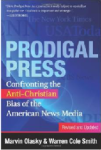
Confronting the Anti-Christian Bias of the American News Media
By Marvin Olasky and Warren Cole Smith
Issuing a clarion call for Christians to reclaim American journalism, Olasky and Smith examine the influence of worldviews on reporting, objectivity, sensationalism, and crusading; the impact of legal, ethical, and technological changes; and the changes brought about by the 24/7 news cycle, the Internet, and social media.
See more study materials at: www.KennethGentry.com
Scriptural balance
Third, the second coming balances the theology of God in Scripture. This glorious doctrine not only finalizes Christ’s redemptive victory (pouring eternal glory on his redeeming love) and completes the plan of God (demonstrating divine wisdom in his creational plan). But it also provides us with a full-orbed doctrinal system balancing out majestic biblical truths. Were it not for the second advent:
Truly, the second coming is a “blessed hope” upon which we must carefully focus. Unfortunately, though it is “blessed” and hope-filled, “eschatology, perhaps more than any other branch of theology, is laden with divisiveness, and this is particularly true in conservative evangelical circles.”1 Tragically, this issue “has been a matter of debate, sometimes acrimonious.”2 Indeed, “perhaps no doctrine has more divided modern evangelical Protestantism.”3 So, before we can properly understand all the implications of the second coming, we must establish our theological context.
Notes
Donald G. Bloesch, The Last Things: Resurrection, Judgment, Glory (Downers Grove, Ill.: InterVarsity, 2004), 28.Gehrard Sauter, Eschatological Rationality: Theological Issues in Focus (Grand Rapids: Baker, 1996), 33.Bloesch, The Last Things, 87.

September 14, 2021
POSTMILLENNIAL EXPECTATIONS IN CREATION FOUNDATIONS
 PMW 2021-067 by Kenneth L. Gentry, Jr.
PMW 2021-067 by Kenneth L. Gentry, Jr.
Does the “Cultural Mandate” in Gen 1:26-28 help the postmillennial argument? Or is it “forced” evidence? One PMT reader expressed doubt that this has anything to do with the postmillennial hope. So I ask:
Does this passage speak to the postmillennial program? I believe it does. And powerfully so.
My reader noted that the Mandate in Gen 1 was given to Adam “even before there are cultures and sin” and that it was given to “the first `man’ to be the chief or to have dominion over the `lower’ creation, God is simply stating no more nor less than the plan fact that man, as the top of the creation chain made in his image, has been given dominion over the earth and everything in it.” He goes on to argue that this text does “not say it’s `Christian’s’ dominating other man/unbelievers, politics or culture, but Man having dominion over creation. Unless we have an agenda where we want to force the clear plain reading of the scripture to our views.”
I appreciate his interest in sound exegetical arguments, and I understand his confusion on this argument. He apparently has not read postmillennial explanations of this passage beyond brief proof-texts for postmillennialism. Let me explain how this passage is valuable to the postmillennial enterprise.
The Mandate and Man’s Fall
It is true that this Mandate was given prior to man’s Fall into sin and that it involved man’s “rule” over the animal kingdom. However, we must ask: Does it apply even after the Fall? And also: How is that rule over the animal kingdom to come to pass?
I would quickly note that the Mandate does continue after the Fall. We see it re-issued in Gen 9:1-5, with slight alterations. There Noah is re-commanded to be fruitful and multiply, as was Adam. And that “the fear of you and the terror of you will be on every beast of the earth” (Gen 9:1-2). This powerful asserts man’s dominance (rule) over the animal kingdom.
Greatness of the Great Commission (by Ken Gentry)
An insightful analysis of the full implications of the great commission. Impacts postmillennialism as well as the whole Christian worldview.
See more study materials at: www.KennethGentry.com
We see this re-stated again in Psalm 8:5-8: “What is man that You take thought of him, / And the son of man that You care for him? / Yet You have made him a little lower than God, / And You crown him with glory and majesty! / You make him to rule over the works of Your hands; / You have put all things under his feet, / All sheep and oxen, / And also the beasts of the field, / The birds of the heavens and the fish of the sea, / Whatever passes through the paths of the seas.”
Thus, clearly the Cultural Mandate is not withdrawn at the Fall. Man still remains God’s image (Gen 9:6b; 1 Cor 11:7).
The Mandate and Man’s Mission
We also must analyze the Mandate in terms of its contextual setting. We may surmise the culture-wide significance of the Mandate as we consider its original issuance. God was speaking to Adam and Eve as two individuals and one family. He is commanding them to bring all of creation under their authority: “God blessed them [these two people]; and God said to them, `Be fruitful and multiply, and fill the earth [obviously be generating other people through reproduction], and subdue it; and rule over the fish of the sea and over the birds of the sky and over every living thing that moves on the earth [which involves the whole earth].”
Simply put: the rule of the whole earth could not be accomplished by Adam and Eve alone. The task is to big. But the task is not to be pursued by Adam and Eve alone: they are to reproduce and fill the earth, creating great numbers of offspring.
We can see the cultural-building implications of this Mandate reflected in Gen 4. There we find very early man (which Adam is still alive) building human culture: Cain’s son Enoch “built a city [Heb.: yir]” (Gen 4:17). A “city” is an organized settlement of people in a community (e.g., Gen 10:12; 11:4; 18:24; etc.). Such cities require communal operations which develop human culture.
An important part of the advance of human culture involves exercising dominion over the animals. For instance, early man in Adam’s time engaged in sheep herding (Gen 4:2), raising livestock (Gen 4:20) and so forth. As we know, this raising of sheep and livestock will lead to food production, trade, the division of labor, and so forth. So exercising dominion over the animals will be more efficiently done by man working in concert together, i.e., developing human culture.

As It Is Written: The Genesis Account Literal or Literary?
Book by Ken Gentry
Presents the exegetical evidence for Six-day Creation and against the Framework Hypothesis.
See more study materials at: www.KennethGentry.com
In fact, we see that culture-building also in early man’s making tents (Gen 4:20), creating music and making musical instrument (Gen 4:21), and working with “all implements of bronze and iron” (Gen 4:22). All of this requires co-operation: not everyone can mine their own ore, create their own musical instruments, raise all of their own food, and so forth. This requires cooperative effort, which is the very definition of building culture. Indeed, “it is not good that man should be alone” (Gen 2:18), which is implied in the Cultural Mandate requiring that man multiply (Gen 1:26, 28).
In addition, my reader cites Gen 9:1-5. This is not only a re-issue of the Cultural Mandate but necessarily entails social and cultural co-operation. The very text itself warns man of killing men: the warning threatens capital punishment against murderers (Gen 9:6). This results from criminal proceedings operating in a social environment under law.
The Mandate and God’s Goal
The Cultural Mandate did not arise as an aspect of man’s rebellion against God. Indeed, it was issued directly by God at man’s very creation. And though man has fallen and corrupts the Mandate, it still remains as God’s calling. And God intends for man to do it to his glory, which by definition means under Christian influence and principle.
If the Mandate is to be properly and fully engaged, it must be done by true believers in God. It therefore comports beautifully with the postmillennial enterprise.
Click on the following images for more information on these studies:
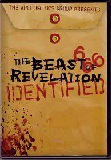

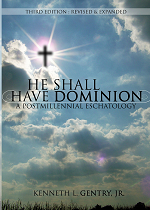
September 10, 2021
PRIMER ON POSTMILLENNIALISM (5)
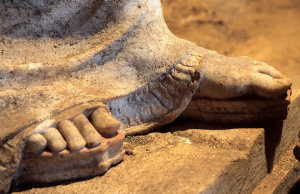 PMW 2021-065 by Kenneth L. Gentry, Jr.
PMW 2021-065 by Kenneth L. Gentry, Jr.
I have been presenting the postmillennial understanding of the millennial hope in this five-part series. Hopefully this series will be useful as an introduction to postmillennialism for those unfamiliar with it or, as yet, unpersuaded by its argument.
In this article we will very briefly consider one of the key texts in Paul’s writing, from the vitally important fifteenth chapter of 1 Corinthians. So then, let us now consider:
Paul and the Postmillennial Hope
Several passages in Paul’s writings encourage the postmillennial outlook, including most prominently Romans 11 and 1 Corinthians 15. We will focus brief on 1 Corinthians 15:20–27 where we discover a Pauline statement that vigorously declares Christ’s kingdom victory in the present era.
1 Corinthians 15:22–24 reads: “For as in Adam all die, so also in Christ all will be made alive. But each in his own order: Christ the first fruits, after that those who are Christ’s at His coming, then comes the end.” This verse contradicts premillennialism in teaching that the resurrection of believers is the finale of history, not the initiation of a new 1000 year period. The resurrection punctuates the end; no new era follows — and certainly no millennium.
Postmillennialism Made Easy (by Ken Gentry)
Basic introduction to postmillennialism. Presents the essence of the postmillennial argument and answers the leading objections. And all in a succinct, introductory fashion.
See more study materials at: www.KennethGentry.com
In 1 Corinthians 15:24 Paul makes a statement that rebuts the amillennial position: “then comes the end, when He hands over the kingdom to the God and Father, when He has abolished all rule and all authority and power.” Here he notes that when the end comes “He hands over the kingdom to the God and Father.” But he also observes that this end will not come until after he has “abolished all rule and all authority and power.”
The Greek here is important. The NASB translates the pertinent phrase as: “when he has abolished.” But the NIV and ESV offer better translations: “after he has abolished.” In the Greek text the hotan is followed by the aorist subjunctive, katargēsē. Such a construction indicates that the action of the subordinate clause precedes the action of the main clause.
Thus, the end will not come until after Christ abolishes all rule and authority. This is not only grammatically necessary, but contextually. The next verse continues: “For He must reign until He has put all His enemies under His feet” (1 Cor 15:25). That is, he is currently reigning and must continue to reign until all of his enemies are vanquished.
Conclusion
This is the postmillennial hope. As Isaiah put it “Now it will come about that In the last days / The mountain of the house of the LORD / Will be established as the chief of the mountains, / And will be raised above the hills; / And all the nations will stream to it. / And many peoples will come and say, / ‘Come, let us go up to the mountain of the LORD’” (Isa 2:2–3).
As Christ expresses it as he approaches the cross: “Now judgment is upon this world; now the ruler of this world will be cast out. And I, if I am lifted up from the earth, will draw all men to Myself” (John 12:31–32).
As Paul declares: “But each in his own order: Christ the first fruits, after that those who are Christ’s at His coming, then comes the end, when He hands over the kingdom to the God and Father, when He has abolished all rule and all authority and power. For He must reign until He has put all His enemies under His feet” (1 Cor 15:23–25).
Click on the following images for more information on these studies:



September 7, 2021
PRIMER ON POSTMILLENNIALISM (4)
 PMW 2021-064 by Kenneth L. Gentry, Jr.
PMW 2021-064 by Kenneth L. Gentry, Jr.
I am continuing a study on the millennial reign of Christ. In this article I will focus on:
Christ and the Postmillennial Hope
In Christ’s earthly ministry we witness the coming of the prophesied kingdom. For instance, in Mark 1:15 we hear the Lord himself proclaim: “The time is fulfilled, and the kingdom of God is at hand; repent and believe in the gospel.” Thus, not only does he declare that “the” time is fulfilled (the prophetically-expected time) and that the “kingdom of God is at hand,” but he also associates it with the proclamation of the gospel. Later in Matthew 12:28 we read him state: “if I cast out demons by the Spirit of God, then the kingdom of God has come upon you.”
This is why we hear of the early Christians being charged with preaching another king (Acts 17:7). This is why Paul informs the Colossians that “He rescued us from the domain of darkness, and transferred us to the kingdom of His beloved Son” (Col 1:13). This is why John can say in Revelation: “He has made us to be a kingdom, priests to His God and Father — to Him be the glory and the dominion forever and ever” (Rev 1:6).
But I want to focus on the Lord’s powerful statement in John 12:31–32: “Now judgment is upon this world; now the ruler of this world will be cast out. And I, if I am lifted up from the earth, will draw all men to Myself.” This sort of statement is exactly what the postmillennialist would expect to hear from Christ.
Let’s note first:
Christ’s dethronement of Satan
As Jesus faces the cross he declares his judgment of the fallen, rebellious world system. Through the horror of the cross he sees the glory of victory. He soon will “cast out” Satan as “the ruler of this world” (John 12:31). What does this mean? Obviously it does not mean Satan is totally removed from any influence in the world, for we see later references to Satan operating in the world.
The Beast of Revelation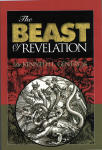
by Ken Gentry
A popularly written antidote to dispensational sensationalism and newspaper exegesis. Convincing biblical and historical evidence showing that the Beast was the Roman Emperor Nero Caesar, the first civil persecutor of the Church. The second half of the book shows Revelation’s date of writing, proving its composition as prior to the Fall of Jerusalem in A.D. 70. A thought-provoking treatment of a fascinating and confusing topic.
For more study materials, go to: KennethGentry.com
To understand this statement in its redemptive-historical context we must understand that before the coming and victory of Christ, all the nations of the world except for little Israel were under the dominion of Satan. In Psalm 147:19–20 we read: “He declares His words to Jacob, / His statutes and His ordinances to Israel. / He has not dealt thus with any nation; / And as for His ordinances, they have not known them.” Similarly in Amost3:2a we read: “You only have I chosen among all the families of the earth.” Therefore Satan could legitimately say to Christ when he offered him “the kingdoms of the world” (Luke 4:5b): “I will give You all this domain and its glory; for it has been handed over to me, and I give it to whomever I wish” (Luke 5:6).
But now Christ declares to his people while standing in the shadow of the cross: “now judgment is upon this world; now the ruler of this world will be cast out.” This dramatic reality appears frequently in the New Testament record. Consider the following four samples of Christ’s victory over Satan:
“But if I cast out demons by the Spirit of God, then the kingdom of God has come upon you. Or how can anyone enter the strong man’s house and carry off his property, unless he first binds the strong man? And then he will plunder his house.” (Matt 12:28–29)
“When He had disarmed the rulers and authorities, He made a public display of them, having triumphed over them through Him.” (Col 2:15)
“Therefore, since the children share in flesh and blood, He Himself likewise also partook of the same, that through death He might render powerless him who had the power of death, that is, the devil” (Heb 2:14)
“The Son of God appeared for this purpose, to destroy the works of the devil” (1 John 3:8)
This is why we notice that some New Testament passages referring to Satan show his curtailed influence in the presence of the Christian faith:
“Taking up the shield of faith with which you will be able to extinguish all the flaming arrows of the evil one.” (Eph 6:17)
“The God of peace will soon crush Satan under your feet.” (Rom 16:20)
“Submit therefore to God. Resist the devil and he will flee from you.” (Jms 4:7)
“Be of sober spirit, be on the alert. Your adversary, the devil, prowls around like a roaring lion, seeking someone to devour. But resist him, firm in your faith.” (1 Pet 5:7–8a)
This can only be because of Christ’s casting out of Satan, his binding his power. And this leads to the ultimate result of Satan’s being cast out:
Christ’s enthronement over men
The Lord defeats Satan so that he is no longer able to dominate the world. The result is that Christ himself will “draw all men to Myself” (John 12:32b).
Notice that profound nature of this declaration. He states that if he is “lifted up” (on the cross, John 12:33) that he will draw “all” men to himself. Not some. Not just Jews. Surely not just a remnant. He is not plucking brands from the fire. Rather he is declaring that he will draw the great mass of men to himself.
“Reformed Interpretation of the Binding of Satan” by Ken Gentry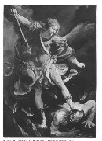
An 8 1/2 x 11 study paper
An exegetical study of Revelation 20:1–3. This study shows that the binding of Satan begins in the first century with the establishing of Christ’s kingdom by the Lord Jesus Christ.
See more study materials at: www.KennethGentry.com
Christ’s kingdom will grow with more and more conversions. Daniel speaks of the kingdom’s coming in Christ during the Roman empire. He states that it will come as a “stone” (Dan 2:45) but that it will become “a great mountain” that fills “the whole earth” (Dan 2:35). Ezekiel sees its gracious influence trickling from the altar in God’s house (Eze 47:1). But it grows to ever greater depths (Eze 47:3-4) until “it was a river that I could not ford, for the water had risen, enough water to swim in, a river that could not be forded.”
Jesus declares this gradualistic advance of his kingdom by comparing it to a mustard seed and to leaven. “He presented another parable to them, saying, ‘The kingdom of heaven is like a mustard seed, which a man took and sowed in his field; and this is smaller than all other seeds, but when it is full grown, it is larger than the garden plants and becomes a tree, so that the birds of the air come and nest in its branches.’ He spoke another parable to them, ‘The kingdom of heaven is like leaven, which a woman took and hid in three pecks of flour until it was all leavened’” (Matt 13:31–33).
Christ’s kingdom is a living principle. It carries within it a growth tendency. Indeed, it will tend to grown until it draws “all men” to Christ (John 12:32). Thus, as John puts it elsewhere: “For God did not send the Son into the world to judge the world, but that the world might be saved through Him” (John 3:17).
To be continued.

September 3, 2021
PRIMER ON POSTMILLENNIALISM (3)
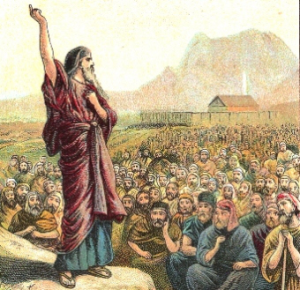 PMT 2021-063 Kenneth L. Gentry, Jr.
PMT 2021-063 Kenneth L. Gentry, Jr.
This is the third in a series of studies on the “millennium” from Rev. 20 and how postmillennialists understand it, especially over against amillennialists.
Prophecy and the Postmillennial Hope
The Old Testament is, of course, full of eschatological pronouncements. Israel was blessed with many writing prophets who have left us a record of their inspired insights into the future. I could profitably survey a number of the Messianic Psalms.
For instance, I could highlight Psalm 2, taking special note of the promise: “Ask of Me, and I will surely give the nations as Your inheritance, / And the very ends of the earth as Your possession” (Psa 2:8). Did Jesus ask for the nations from the father? Yes, he did as we see in his Great Commission: “And Jesus came up and spoke to them, saying, ‘All authority has been given to Me in heaven and on earth. ‘Go therefore and make disciples of all the nations, baptizing them in the name of the Father and the Son and the Holy Spirit’” (Matt 28:18–29).
Or I could focus on Psalm 22, the great psalm presenting us with the crucifixion of Christ. In that Psalm we hear the promise that results from the death of Christ: “All the ends of the earth will remember and turn to the LORD, / And all the families of the nations will worship before You” (Psa 22:27).
Amillennialism v. Postmillennialism Debate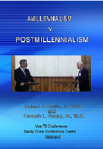
(DVD by Gentry and Gaffin)
Formal, public debate between Dr. Richard Gaffin (Westminster Theological Seminary)
and Kenneth Gentry at the Van Til Conference in Maryland.
See more study materials at: www.KennethGentry.com
Or I could turn to the most quoted and alluded to Old Testament verse in the New Testament. Psalm 110:1 declares: “The LORD says to my Lord: / ‘Sit at My right hand / Until I make Your enemies a footstool for Your feet.’” At his ascension Jesus was seated at the right hand of God until his enemies are defeated.
But due to space constraints, I will briefly analyze one important Isaianic prophecy:
“Now it will come about that In the last days / The mountain of the house of the LORD / Will be established as the chief of the mountains, / And will be raised above the hills; / And all the nations will stream to it. / And many peoples will come and say, / ‘Come, let us go up to the mountain of the LORD, / To the house of the God of Jacob; / That He may teach us concerning His ways / And that we may walk in His paths. / For the law will go forth from Zion / And the word of the LORD from Jerusalem. / And He will judge between the nations, / And will render decisions for many peoples; / And they will hammer their swords into plowshares and their spears into pruning hooks. / Nation will not lift up sword against nation, / And never again will they learn war.” (Isa 2:2–4)
Isaiah’s Prophetic Time Frame
It is very important that we discern when Isaiah expects his prophecy to be fulfilled. It opens with these important words: “Now it will come about that / In the last days. . . .” But what are “the last days”? And when do they occur? We find the answer to our questions in the New Testament, the infallible interpreter of the Old Testament.
I believe that Scripture teaches that the “last days” begin in Christ’s earthly ministry in the first century and will continue until the “last day” resurrection” (John 6:39, 40, 44, 54) at the end of history (hence, it is the “last” day). We see evidence that the last days cover the full expanse of the current gospel age in several places in the New Testament. I will mention just three.
Peter explains the Pentecostal phenomena by declaring that they signal the coming of the last days: “this is what was spoken of through the prophet Joel: ‘and it shall be in the last days,’ God says, ‘that I will pour forth of my Spirit on all mankind’” (2:16–17a).
Paul looks back to Israel in the wilderness after their exodus from Egypt and writes to the first-century Corinthian Christians: “these things happened to them as an example, and they were written for our instruction, upon whom the ends of the ages have come” (1 Cor 10:11).
The writer of Hebrews follows suit when he comments on Jesus’ earthly ministry: “God, after He spoke long ago to the fathers in the prophets in many portions and in many ways, in these last days has spoken to us in His Son” (Heb 1:1–2a). He is setting the current new covenant era over against the former days that lead up to them. And he defines the present as “the last days.”
Thus, I believe that we have been in the last days since Jesus’ first-century ministry and that we will continue living in the last days until the resurrection at “the last day” (John 6:39; 11:24). So now I would point out that Isaiah declares that his prophecy will occur “in the last days” (Isa 2:2a). That is, during the progress of the period known as “the last days.” This will not occur after the last days — in a new era millennium or the eternal state — but in the last days before they end of our current age.
Isaiah’s Prophetic Expectation
This great prophecy expects something glorious to occur during the period of the last days, in the Christian era: “Now it will come about that In the last days / The mountain of the house of the LORD / Will be established as the chief of the mountains, / And will be raised above the hills” (Isa 2:2a-b).
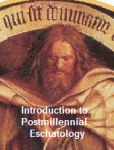
Introduction to Postmillennial Eschatology (10 mp3 lectures)
Southern California Center for Christian Studies seminar.
Lecture presentations and some classroom interaction.
Very helpful definition, presentation, and defense of postmillennialism.
See more study materials at: www.KennethGentry.com
Before commenting on exactly what this expects, I would note up front that the prophecy is strongly emphasizing something. In the Hebrew the word for “established” here is kûn which is a strong term that indicates firmness. Syntactically it appears in the first position for emphasis. The statement effectively reads: “established firmly will be the mountain off the house of the Lord.”
Then Isaiah adds as a consequence of its firm establishment that “all the nations will stream to it. / And many peoples will come and say, / ‘Come, let us go up to the mountain of the LORD, / To the house of the God of Jacob; / That He may teach us concerning His ways / And that we may walk in His paths. / For the law will go forth from Zion / And the word of the LORD from Jerusalem” (Isa 2:2d–3).
But now the question arises: What will be established? To what is he referring when he mentions “the mountain of the ho use of the Lord,” “Zion,” and “Jerusalem”?
The “house of the Lord” refers to the temple of God. It is the place where Israel found the special presence of God. That which gives the “house” its significance is the indwelling presence of God’s Shekinah glory.
But when we read the New Testament (which initiates the “last days”) we discover the house of the Lord (the temple) becomes the body of Christ (the church). Because the final blood-letting is in Christ, redemptive-history no longer requires a temple for sacrifices (Heb 10:10). Thus, in Ephesians 2:21–22 we read: “in whom the whole building, being fitted together, is growing into a holy temple in the Lord, in whom you also are being built together into a dwelling of God in the Spirit.” 1 Peter 2:5a agrees: “you also, as living stones, are being built up as a spiritual house.” We see this imagery elsewhere, as well (1 Cor 3:16; 6:19; 2 Cor 6:16).
That this exalted “house of the Lord” is the body of Christ, the church, is also confirmed in two other images Isaiah employs: Zion and Jerusalem. To the first-century Jewish Christians who are being tempted with returning to Judaism, the writer of Hebrews states: “you have come to Mount Zion and to the city of the living God, the heavenly Jerusalem” (Heb 12:22). What is more, like Isaiah’s firmly established mountain, Hebrews continues encouraging these Jewish converts: “therefore, since we receive [i.e., “are currently receiving,” paralambonontes, pres. act. ptcp.] a kingdom which cannot be shaken, let us show gratitude” (Heb 12:28). In other words, these central realities in the old covenant have now been transformed into spiritual realities that are accessed in Christ. And they partake of the same unshakeable quality to which Isaiah’s prophecy points.
Postmillennialism believes that Christ’s church (in all that it involves) will be exalted and become the chief influence in the world during the course of the last days.
Isaiah’s Prophetic Method
Postmillennialism also differs from premillennialism’s catastrophism in bringing in the full-blown kingdom all at once by miraculous divine intrusion (the visible return of Christ). Rather we discern in Isaiah 2 (and elsewhere) that the kingdom will ascend to dominance by evangelistic endeavor.
Isaiah relates the method of prophetic victory: “many peoples will come and say, / ‘Come, let us go up to the mountain of the LORD, / To the house of the God of Jacob’” (Isa 2:3b). This speaks of gospel victory among the nations, that is, of evangelistic success. Then following upon this evangelistic flow to the mountain of the Lord, we read of their being discipled: “that He may teach us concerning His ways / And that we may walk in His paths” (Isa 2:3c). All of this reflects the success of Christ’s Great Commission: “Go therefore and make disciples of all the nations, baptizing them in the name of the Father and the Son and the Holy Spirit, teaching them to observe all that I commanded you” (Matt 28:19–20a).
Isaiah’s Prophetic Result
Following upon the exaltation of the mountain of the house of the Lord (the Christian church) by the twin processes of evangelism and discipleship, we discover a glorious result:
“the law will go forth from Zion / And the word of the LORD from Jerusalem. / And He will judge between the nations, / And will render decisions for many peoples; / And they will hammer their swords into plowshares and their spears into pruning hooks. / Nation will not lift up sword against nation, / And never again will they learn war” (Isa 2:3d–4).
This is the postmillennial hope: proclamation of the gospel, conversions to its message, discipleship in its truths, and all leading to a transformed socio-political order rejoicing in international peace. And again: all of this is to transpire “in the last days.” Not after them. We are in the kingdom now. In fact, most in the audience of the Criswell Theological Review are non-Jews who have been swept into the kingdom of God by evangelistic methods. The kingdom has grown and it will continue to grow until the full, global victory is won.
In my next article I will continue this series with a study of Christ and the postmillennial hope.

August 31, 2021
PRIMER ON POSTMILLENNIALISM (2)
 PMW 2021-062 by Kenneth L. Gentry, Jr.
PMW 2021-062 by Kenneth L. Gentry, Jr.
In my last article I began considering the distinctive approach to the millennium in the postmillennial view, and as over against amillennialism. Though amillennialism and postmillennialism are closely related, they are distinct.
Defining Postmillennialism
So now: What is the postmillennial outlook? Why is it called post-millennial? And what are its expectations?
Postmillennialism teaches that Christ will return to earth after a long era of gospel progress and worldwide righteousness. As the gospel wins greater influence the world will witness a long era of social stability, economic development, and international peace.
The basic structure of the postmillennial hope is as follows:
First, Christ came into the world in the first century and established his kingdom, the Messianic kingdom prophesied in the Old Testament. We are in that kingdom now (the “millennium,” if you will) (Luke 17:20–21; Col 1:13).
Second, he confronted and defeated Satan while on earth, through his ministry, death, burial, resurrection, and ascension. Satan is bound from deceiving the nations, so that they are open to the power of the gospel (Matt 12:28–29; Rev 20:3).
Three Views on the Millennium and Beyond
(ed. by Darrell Bock)
Presents three views on the millennium: progressive dispensationalist, amillennialist, and reconstructionist postmillennialist viewpoints. Includes separate responses to each view.
See more study materials at: www.KennethGentry.com
Third, he gave the marching orders for his kingdom in the “Great Commission.” This commission is great because it is established on his grant of “all authority,” he command to “make disciples of all the nations,” his directive for us to teach the nations “all that I commanded you,” and his promise that “I am with you always, even to the end of the age” to get it done (Matt 28:18–20).
Fourth, he promised to bless his kingdom with growth, likening it to a mustard seed that begins incredibly small but results in a tree that dominates the garden; and comparing it to leaven that leavens the entire bushel (Matt 13:31–33).
Fifth, the world will eventually be converted, becoming a “Christianized” world. At the height of Christ’s kingdom’s development the overwhelming majority of men will be born-again of God’s grace which will lead them a peaceable, worldwide kingdom (Isa 11:9; John 3:17).
Sixth, at the end of history after a long era of gospel victory, Christ will return bodily, visibly, and gloriously (Acts 1:9–11). He will raise the dead in a general resurrection (John 5:29; Acts 24:15) and will conduct the final judgment (Acts 17:31; Rom 2:5–6). He will then end world history and establish the consummate order resulting in a physical new creation (2 Pet 3:10–13).
Thus, postmillennialism teaches that Christ wins the victory in history, before he returns (hence, it is post-millennial). It offers believers the optimistic prospect of earthly victory and historical hope. In fact, postmillennialism is the only evangelical eschatological system that is historically optimistic. Of course, all evangelical systems are optimistic in believing that Christ ultimately wins the victory: premillennialists at his coming when he establishes the earthly millennium; amillennialists at his coming when he ends history by defeating Satan and setting up the eternal order.
[image error]For more information and to order click here.
" data-image-caption="" data-medium-file="https://postmillennialismtoday.files...." data-large-file="https://postmillennialismtoday.files...." class="alignright size-full wp-image-254" src="https://postmillennialismtoday.files...." alt="When Shall These Things Be? A Reformed Response to Hyperpreterism" />When Shall These Things Be?
(ed. by Keith Mathison)
A reformed response to the aberrant HyperPreterist theolgy.
Gentry’s chapter critiques HyperPreterism from an historical and creedal perspective.
See more study materials at: www.KennethGentry.com
But what I mean by claiming that postmillennialism is the only eschatological system that offers historical hope is: it is the only system offering hope within the continuous, unfolding history in which we presently live. It offers a distinctive hope in three important senses:
First, as systems of gospel proclamation, both amillennialists and premillennialists do not expect a majority influence for the gospel. Whereas postmillennialists believe that the gospel will win the victory in the historical program under which we now live.
Second, as systems of historical understanding, amillennialists and premillennialists expect that history will decline into irresistible chaos and upheaval. Whereas postmillennialists believe that history is moving toward a time of great righteousness and prosperity under the gospel.
Third as systems of evangelistic discipleship, postmillennialists train Christians for wide-scale, cultural, social, and political success in the world.
But now: why do we believe in large-scale historical progress? Obviously in one article I cannot cover the entire biblical argument. In fact, in my 600 page He Shall Have Dominion I even had to cut short the full argument. So I will only briefly highlight why we believe such. I will focus on one Old Testament prophecy, a few verses in Jesus’ teaching, and one important passage in Paul.
(To be continued.)
August 27, 2021
PRIMER ON POSTMILLENNIALISM (1)
 PMW-2021-061 Kenneth L. Gentry,
PMW-2021-061 Kenneth L. Gentry,
Postmillennialism and amillennialism are closely related. In fact, they are both “post” millennial in that they believe the current age (the Church Age, if you will) is the “millennium,” and that Christ will return “post” (after) the millennium.
Both Post- and Amillennialists note that the “thousand year” reign of Christ occurs in only one passage in Scripture, Revelation 20:1–6. We further observe that it appears in the most symbolic book in all of Scripture. In Revelation we see a seven-headed beast, fire-breathing horses, locusts with the faces of men and the teeth of lions, a woman standing on the moon, and many more symbolic features. Consequently, we prefer that eschatological discussion begin elsewhere in more didactic portions of Scripture, and that it be controlled by passages other than the apocalyptically-charged, highly-wrought symbolic images in Revelation
The millennial passage in Revelation 20 is prominent in contemporary eschatological discussion today. Indeed, it has given us the eschatological nomenclature highlighting our distinctive eschatological positions as millennial views. Yet I agree with James Blevins in the Mercer Bible Dictionary when he complains: “The millennium becomes the tail that wags the dog.”
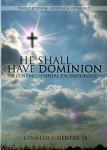
He Shall Have Dominion
(paperback by Kenneth Gentry)
A classic, thorough explanation and defense of postmillennialism (600+ pages). Complete with several chapters answering specific objections.
See more study materials at: www.KennethGentry.com
As a postmillennialist I do not see Revelation 20 as a key text for eschatological discussion. I do believe it is an important text for the story-line of Revelation. But biblical eschatology begins far earlier than in one of the last books of the Bible. And it is exhibited more clearly in those earlier passages.
In fact, by definition “eschatology” emphasizes end-time events. But Revelation is tied to the first century. John introduces and closes his remarkable vision with clear, near-term expectation statements:
“The Revelation of Jesus Christ, which God gave Him to show to His bond-servants, the things which must soon take place; and He sent and communicated it by His angel to His bond-servant John.” (Rev 1:1)
“Blessed is he who reads and those who hear the words of the prophecy, and heed the things which are written in it; for the time is near.” (Rev 1:3)
“And he said to me, ‘These words are faithful and true’; and the Lord, the God of the spirits of the prophets, sent His angel to show to His bond-servants the things which must soon take place.” (Rev 22:6)
“And he said to me, ‘Do not seal up the words of the prophecy of this book, for the time is near.’” (Rev 22:10)
Besides this, Revelation 20 (the famed millennial passage) is actually the answer to the cry of the first-century martyrs mentioned earlier (and throughout Revelation). It has nothing to do with all Christians throughout Christian history. We can see this in the shared words and parallel assertions found between Revelation 6:9–10 and Revelation 20:4:
“When the Lamb broke the fifth seal, I saw underneath the altar the souls of those who had been slain because of the word of God, and because of the testimony which they had maintained; and they cried out with a loud voice, saying, ‘How long, O Lord, holy and true, will You refrain from judging and avenging our blood on those who dwell on the earth?’” (Rev 6:9–10)
“Then I saw thrones, and they sat on them, and judgment was given to them. And I saw the souls of those who had been beheaded because of their testimony of Jesus and because of the word of God, and those who had not worshiped the beast or his image, and had not received the mark on their forehead and on their hand; and they came to life and reigned with Christ for a thousand years.” (Rev 20:4)
Thine Is the Kingdom
(ed. by Ken Gentry)
Contributors lay the scriptural foundation for a biblically-based, hope-filled postmillennial eschatology, while showing what it means to be postmillennial in the real world.
See more study materials at: www.KennethGentry.com
We should note that according to the direct statements within Revelation 20:4, John is dealing with those Christians who had been slain because of their commitment to God’s word (thus, he sees “souls” and he declares they were “beheaded”). He also adds that they “had not worshiped the beast” (whom I believe to be Nero Caesar, the first imperial persecutor of the church). Both of these facts fit within the time-frame designates of Revelation, i.e., that the events must “soon take place” (Rev 1:1; 22:6) because “the time is near” (Rev 1:3; 22:10). Both of these facts also militate against a future, earthly millennial reign of all the saints on earth.
Consequently, we must understand that biblical eschatology deals with the larger question of cosmic history, rather than narrowly focusing on the trials of the first-century church. Hence, postmillennialists go elsewhere to develop our eschatological outlook.
(To be continued in the next article.)
August 3, 2021
THE SIGNIFICANCE OF AD 70
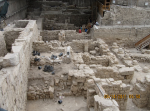 PMW 2021-060 by Kenneth L. Gentry, Jr.
PMW 2021-060 by Kenneth L. Gentry, Jr.
Today we are so distant from the events of AD 70, so removed from the ancient culture, so little acquainted with the first-century Jewish outlook, and so accustomed to the Christian perspective, we tend to overlook the enormous redemptive-historical significance of AD 70. Those events are not merely another sad instance in the history of “man’s inhumanity to man which makes countless thousands mourn.” They serve not as demonstration of “nature, red in tooth and claw.” Neither do they merely remind us of “the carnage of war, the blood-swollen god.”
But such is mistaken. Rather the devastating events of the Jewish War are the historical manifestations of the furious wrath of the offended God of Israel. Transcendent realities stand back of these temporal events. With Nahum we see the smoke of destruction as the dust clouds from God’s feet (Na 1). We learn that truly “it is a fearful thing to fall into the hands of the living God” (Heb 10:27) for “our God is a consuming fire” (Heb 10:31).
Israel’s failure and God’s response
Jehovah God sent His own Son to his covenant people, but they “received him not” (Jn 1:11). Indeed, they spitefully abused him in defiance of his gracious and loving overtures (Mt 11:28; 21:33-46; 23:34-47; Ac 7:51-53). Consequently, with His rejection, “the sons of the kingdom were cast out” (Mt 8:12), and “the kingdom of God was taken” from them (Mt 21:43).
In the Days of These Kings: The Book of Daniel in Preterist Perspective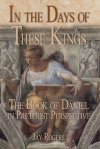
by Jay Rogers
This orthodox preterist analysis of Daniel is not a book, but a library. Extremely helpful for the postmillennial orthodox preterist.
For more study materials, go to: KennethGentry.com
Hebrews was written to warn of the disastrous consequences of Jewish Christians apostatizing back into Judaism (Heb 2:1-4; 6:1-4; 10:26-31), just as Jesus had warned (Mt 24:10, 12). It portrays “the day drawing near” (Heb 10:25; cp. Ac 2:16-20,40). This would effect a grand change in God’s redemptive administration — a change that both the author of Hebrews and John liken to “a new Jerusalem” (21:1; cp. 2Co 5:17; Gal 6:15; Heb 12:22; Rev 21:2), which is Christianity (Heb 12:23-25; cp. Gal 4:25-26; Rev 14:1-5).
In Hebrews 12 the writer powerfully presents his conclusion to his book-long warning. After reminding them from whence they had originally come (OT Israel, Heb 12:18-21), he informs them of where they have most recently been (NT Christianity):
“But you have come to Mount Zion and to the city of the living God, the heavenly Jerusalem, and to myriads of angels, to the general assembly and church of the first-born who are enrolled in heaven, and to God, the Judge of all, and to the spirits of righteous men made perfect, and to Jesus, the mediator of a new covenant, and to the sprinkled blood, which speaks better than the blood of Abel” (Heb 12:22-24).
But many are defecting back to Judaism. And at the worst possible time. They were leaving the spiritual, anti-typical, fulfillment realities of Christianity to return to the material, typical, ceremonial world of a now-defunct Judaism. This apostasy occurred when God was about to “shake not only the earth, but also the heaven” (Heb 12:26). The shaking of the “created things” (12:27) speaks of the destruction of the temple system with its “made with hands” ritual implements (9:11, 24; cp. Mk 14:58), which are “ready to vanish away” (8:13; cp. Jn 4:21; Ac 6:14; 7:48; 2Co 3:11; Gal 4:25-30). In place of the OT system, Christianity will remain as a “kingdom which cannot be shaken” (12:28).
Israel’s failure and John’s Revelation
John’s message in Revelation performs the same play but on a different stage and in slightly different dress. John’s new creation presents a new world order: Christianity, which arises from within Israel (Rev 12) and remains after the destruction of the Jewish temple-based system (Rev 11). We know this is John’s point because immediately after describing the new creation in Revelation 21:1–22:5, we read:
“’These words are faithful and true’; and the Lord, the God of the spirits of the prophets, sent His angel to show to His bond-servants the things which must shortly take place. And behold, I am coming quickly…. Do not seal up the words of the prophecy of this book, for the time is near” (22:6-7, 10).
The Harrowing of Hell (by Jay Rogers)
This postmillennial book examines the power of the Gospel, not only to overcome all opposition, but to rise far above the powers of hell. The term “Harrowing of Hell” refers to idea that Christ descended into Hell, as stated in the Apostles’ Creed.
For more Christian educational materials: www.KennethGentry.com
Though even today we await a final, consummational, eternal new creation order (2Pe 3:7-13), we now live in the preparatory, spiritual new creation order established in the first-century. Calvin comments on Isaiah 65:17 noting that the “new heavens and new earth” is metaphorical language that “promises a remarkable change of affairs” when God “restores his Church” so that it “shall appear to gain new life and to dwell in a new world” (Isaiah, ad loc.). Westminster divine John Lightfoot even relates it to the destruction of Jerusalem “which is very frequently expressed in Scripture as if it were the destruction of the whole world” (2:318). We know Isaiah 65 does not speak of the consummate order for it includes child bearing, sinners, death, and curse (Isa 65:20).
July 30, 2021
CREATION, EDEN, AND POSTMILLENNIALISM
 PMW 2021-059 by Kenneth L. Gentry, Jr.
PMW 2021-059 by Kenneth L. Gentry, Jr.
The God of creation is a God of covenant. Scripture structures God’s relationship to and rule over both man and creation in covenantal terms.
Creation Covenant
Though the term “covenant” (Heb.: berith) does not appear in Genesis 1, the constitutive elements of a covenant are there. Jeremiah, however, uses the word “covenant” of creation. In Jeremiah 33:24-25 the creation covenant that secures the regularity of the days and seasons serves as a ground of hope in God’s covenantal faithfulness to his people in the world: “This is what the Lord says: If I have not established my covenant with day and night and the fixed laws of heaven and earth, then I will reject the descendants of Jacob and David my servant and will not choose one of his sons to rule over the descendants of Abraham, Isaac and Jacob. For I will restore their fortunes and have compassion on them.’”
Hosea 6:7 also indicates a covenantal framework for Adam’s Edenic experience: “Like Adam, they have broken the covenant — they were unfaithful to me there.”
In the creation covenant, God appoints man as his vice-regent over the earth. The Lord creates man in his image and places all creation under him to be developed to God’s glory. Although a rich constellation of ideas cluster around the image of God, textually we know that at least one major concept involves man’s rule over the earth:
“Then God said, Let us make man in our image, in our likeness, and let them rule over the fish of the sea and the birds of the air, over the livestock, over all the earth, and over all the creatures that move along the ground. . . .’ God blessed them and said to them, Be fruitful and increase in number; fill the earth and subdue it. Rule over the fish of the sea and the birds of the air and over every living creature that moves on the ground’” (Gen. 1:26, 28).
As the image of God under covenantal obligation, Adam and Eve must develop human culture to his glory, exercising righteous dominion over all the earth. This, of course, cannot be done by Adam and Eve alone, so God blesses and commands them: “Be fruitful and increase in number; fill the earth” so that they might obediently “subdue it” (Gen. 1:28a). The empowerment to dominion (the “image of God”) for man’s good (“God blessed them”) is followed up with the authorization (“let them rule”) and the obligation (“God . . . said to them . . , Rule’”) to dominion.
The Truth about Postmillennialism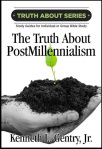 By Ken Gentry
By Ken Gentry
A group Bible study guide for explaining the optimistic prophetic hope for this world to be accomplished before Christ’s Second Coming. Establishes the postmillennial system in both the Old and New Testaments. Touches on key eschatological issues, such as creation, covenant, interpretive methodolgy, the great tribulation, the Book of Revelation, the Jewish Temple, and more. It presents and answers the leading objections to postmillennialism.Twelve chapters are ideal for one quarter of Sunday School.
See more study materials at: www.KennethGentry.com
And in that human culture is the sum deposit of man’s normative activities in the world, this necessitates the corporate activity of men working in concert. This requires social order and civil polity to promote the development of civilization and the progress of culture. Contrary to humanistic evolutionary assumptions the Bible infallibly records early man’s development of culture. In fact, it proceeds at a remarkably rapid pace: man begins cattle farming, creates musical instruments, and works with metals while Adam is still living (Gen. 4:17-22). This is man’s holy calling, his God-ordained, creational drive. As Gary North puts it: “Man must exercise dominion. It is part of his nature to do so.” [1]
Tragically though, sin enters the world so that “as a result of the fall . . . man’s urge to dominion is now a perverted one, no longer an exercise of power under God and to his glory, but a desire to be God. This was precisely the temptation of Satan, that every man should be his own god, deciding for himself what constitutes right and wrong (Gen. 3:5).” [2]
Edenic Covenant
In response to man’s rebellious treason, God, who creates the world for his own glory, acts in sovereign mercy to initiate covenantal redemption in order to effect reconciliation with his fallen creature. In the very historical context of the fall God promises redemption and pledges to crush Satan who sparks man’s rebellion. To the serpent used by and representative of Satan, God says: “And I will put enmity between you and the woman, and between your offspring and hers; he will crush your head, and you will strike his heel” (Gen. 3:15). This is the Edenic covenant, which is the foundation of redemption and supplements the creation covenant.
Here we have the protoevangelium, the first promise of the gospel. This passage anticipates struggle in history: the seeds of the representative participants in the fall will engage in mortal conflict. Ultimately, this is a cosmic struggle between Christ and Satan, a contest played out on earth and in time between the city of man (under the dominion of Satan) and the city of God. Its historical nature is crucial to grasp: the fall occurs in history; the struggle ensues in history; the focal seed of the woman appears in history (the historical Christ who is the incarnation of the transcendent Creator, John 1:1-3, 14).
Significantly for the eschatological debate this historical struggle ends in historical victory: the seed of the woman (Christ) crushes the seed of the serpent (Satan). We know from the New Testamental evidence that the historical crucifixion and resurrection of Christ legally effect Satan’s ruin: “And having disarmed the powers and authorities, he made a public spectacle of them, triumphing over them by the cross” (Col. 2:15). Indeed, this is a fundamental motive to his incarnation, for “the reason the Son of God appeared was to destroy the devil’s work” (1 John 3:8b; cp. Heb. 2:14). We further learn that Christ’s redemptive labor will have consequences in history: “Now is the time for judgment on this world; now the prince of this world will be driven out. But I, when I am lifted up from the earth, will draw all men to myself” (John 12:31-32). Christ’s historical lifting up, on which his victory is predicated, occurs either at the crucifixion, resurrection, or ascension — or most probably all three considered as a redemptive unit.
The Book of Revelation and Postmillennialism (Lectures by Ken Gentry)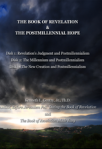
In the first of these three 50-minute lectures Gentry explains Revelation’s judgments to show they do not contradict postmillennialism. In the next two lectures he shows how the Millennium and the New Creation themes strongly support the gospel victory hope found in postmillennialism.
See more study materials at: www.KennethGentry.com
Postmillennialists emphasize the covenantal crushing of Satan in history at Christ’s first advent, with its results being progressively worked out in history on the plane of Adam’s original rebellion, Satan’s consequent struggle, and Christ’s incarnational intrusion. The protoevangelium promises in seed form (no pun intended) the victory of Christ in history, just as the fall and its effects are in history. The First Adam’s fall will be overcome by the Second Adam’s lifting up. God does not abandon history.
Notes
1. Gary North, The Dominion Covenant, 29.
2. Rousas John Rushdoony, The Institutes of Biblical Law, 448.
Kenneth L. Gentry Jr.'s Blog
- Kenneth L. Gentry Jr.'s profile
- 85 followers



